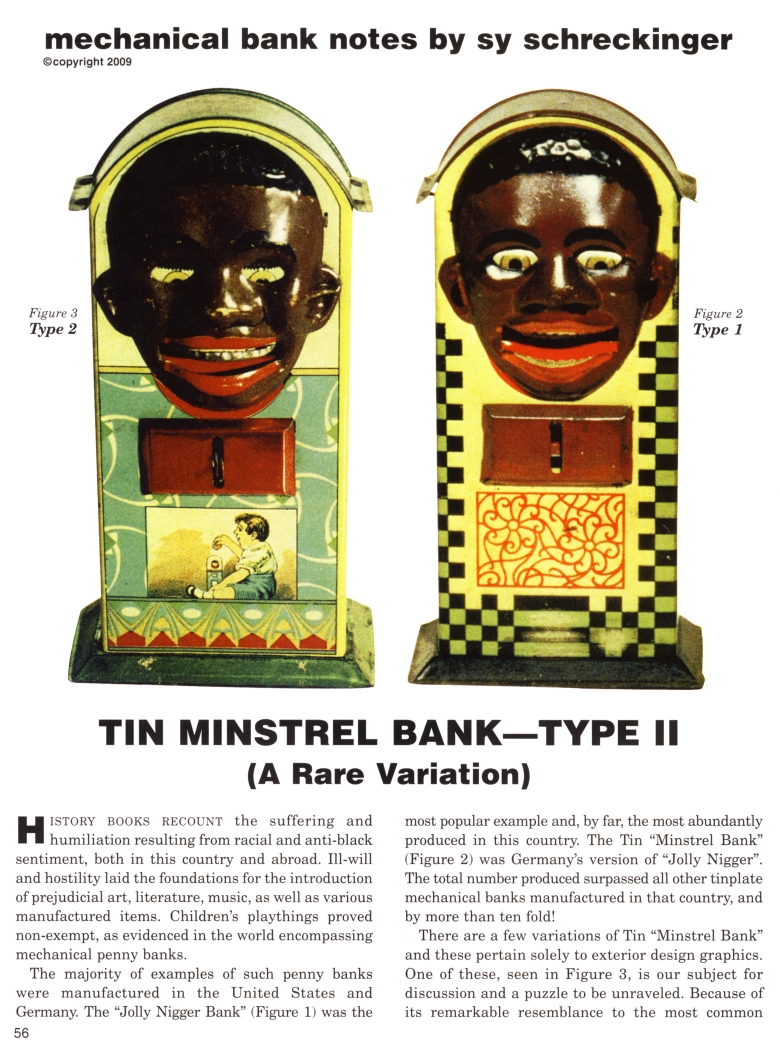|
Tin Minstrel Bank - Type
II
(A Rare Variation)
by Sy Schreckinger – ANTIQUE TOY WORLD Magazine – November, 2009
HISTORY BOOKS RECOUNT the suffering and
humiliation resulting from racial and anti-black sentiment, both in this
country and abroad. III-will and hostility laid the foundations for the
introduction of prejudicial art, literature, music, as well as various
manufactured items. Children's playthings proved non-exempt, as evidenced
in the world encompassing mechanical penny banks.
The majority of examples of such penny banks were
manufactured in the United States and Germany. The "Jolly Nigger Bank"
(Figure 1) was the most popular example and, by far, the most abundantly
produced in this country. The Tin "Minstrel Bank" (Figure 2) was Germany's
version of "Jolly Nigger". The total number produced surpassed all other
tinplate mechanical banks manufactured in that country, and by more than
ten fold!
There are a few variations of Tin "Minstrel Bank" and
these pertain solely to exterior design graphics. One of these, seen in
Figure 3, is our subject for discussion and a puzzle to be unraveled.
Because of its remarkable resemblance to the most common example (Figure
2), it was thought to have been a creation of Saalheimer and Strauss Tin
Works. Located in Nurnberg, Germany, then the center of European tinplate
toy production, this firm was a prestigious and important manufacturer of
tin toys, novelty items and mechanical banks.
Figure 4 represents a page from a Saalheimer and
Strauss wholesale catalog, circa 1923, in which their "Minstrel Bank" was
featured. Imprinted below the minstrel's face is an instructive verse.
Activation of the mechanical (Figure 2) is achieved by following these
instructions: "Press the lever lightly, Watch my tongue appear, Save a
penny nightly, Make your fortune here". Initially, the lever located at
the side of the bank is thrust downward and held in position. A coin is
then placed upon the minstrel's protruding tongue, as indicated in Figure
5. When the lever is released, the tongue and money recede into the bank.
Deposits are retrieved by unlocking the square key-lock coin retainer
underneath the base.
With one exception, all variants of "Minstrel Bank"
appear identical and operate in a similar manner. The exception is that
the most common example, seen in Figure 2, and the scarcest example
(Figure 3) do not exhibit a verse beneath the minstrel's face.
The assumption of manufacture by Saalheimer and Strauss
prevailed until recently when a fully intact, flat tinplate, lithographed
sheet was discovered. It contained several images similar to those
decorating the facade of the "Minstrel Bank" seen in Figure 3. Flat sheets
of lithographed tinplate such as these are utilized by the toy
manufacturer to be inserted into a die cutting, bending and assembling
machine in order to create a finished mechanical bank.
Interestingly, the following wordage had been imprinted
upon the aforementioned tinplate sheet: "M.N.2 E. Sanchez – 11 – 11 – 29 –
1.1.20 Ejemplases PLANTILLA Nrd 158-RICO – S.A." This loosely translates
as: Template Example, Number 158, Design Patent, E. Sanchez, on November
11, 1929, Rico, South America. (Author's note: It is merely an assumption
on my part that the initials "S.A" represent "South America".)
Unfortunately, with only limited information, and until
additional factual data is uncovered, one can only offer assumptions and
possibilities as to who might have actually manufactured the bank seen in
Figure 3. Conceivably, Mr. Sanchez supplied Saalheimer and Strauss with
the design graphics of his bank. The company, in turn, translated the
images to lithographed tinplate sheets. These were utilized to create the
completed mechanical banks, (Figure 3), which were then forwarded to Mr.
Sanchez for distribution in his country. A second explanation may be that
Mr. Sanchez himself had produced the mechanical after acquiring the
tinplate bank-forming machinery from Saalheimer and Strauss.
In sharp contrast to the common Saalheimer and Strauss
"Minstrel Bank" (Figure 2), the E. Sanchez example is considered quite
scarce, with few examples appearing in present day collections. Despite
its fragile tinplate construction and diminutive size (i.e. Height: 6-7/8
inches. Width: 2-7/8 inches), the "Minstrel Bank", (Figure 3), is an
extremely illusive, attractive and desirable addition to a mechanical bank
collection.
Acknowledgments: The superb example "Minstrel Bank"
(Figure 2) was photographed from the collection of Steve and Marilyn
Steckbeck.
The superb example E. Sanchez "Minstrel Bank" (Figure
3) is in the collection of Bob Weiss.
|


